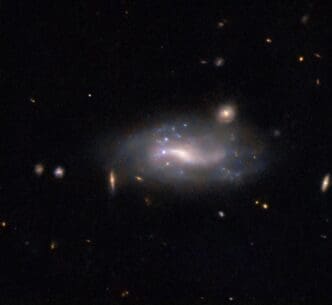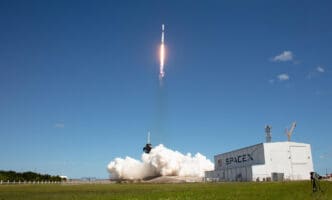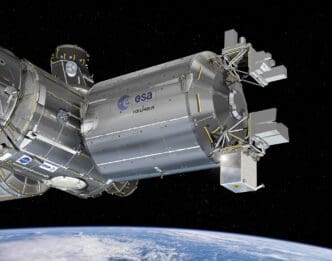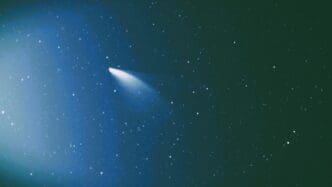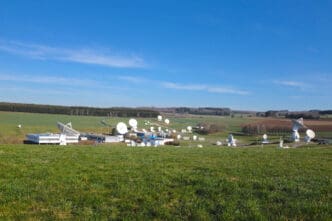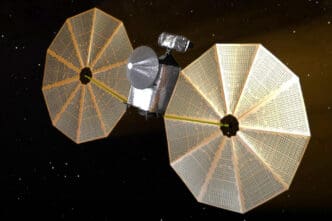Have you ever wondered how scientists manage to capture the fleeting moment of a supernova? It seems almost magical, doesn’t it? Thanks to the Hubble Space Telescope, we now have an eye on the universe that never sleeps. It’s on a quest, a cosmic hunting venture if you will, searching the universe for exploding stars and their secrets.
The latest venture, a captivating quest led by the Hubble team, takes us to the constellation Sculptor. Here, amidst the vast depths of space, lies the fascinating galaxy LEDA 132905. It’s a great distance away, over 400 million light-years, and yet, Hubble managed to capture a supernova, a stellar death throe named SN 2022abvt. These occurrences not only light up our universe but also help scientists unravel the mysteries of space distances.
A Stellar Spectacle: The Intriguing Galaxy LEDA 132905
LEDA 132905 is not just any galaxy. It’s a spiral galaxy nestled over 400 million light-years from Earth in the constellation Sculptor. Through the lens of Hubble, its spiral arms, faint yet discernible, paint a picture of cosmic beauty. What makes this galaxy truly striking, though, are the bright blue stars scattered across its structure, marking regions of vigorous star formation. Amidst this celestial spectacle lies SN 2022abvt, the supernova that has captured the attention of astronomers worldwide.
The light from LEDA 132905, despite its staggering distance, stands testament to the power of modern astrophotography. The supernova SN 2022abvt glows with a pinkish hue at the center, a backdrop of stellar phenomena and cosmic glamour. It’s not just about the light we see today, but the story of its past that unfolds with every flicker from this galaxy.
Why Supernovae Matter
Supernovae are not mere fireworks in the void; they play a crucial role in the cosmic cycle. When a star goes supernova, it becomes a cosmic lighthouse, a beacon that helps scientists measure the vast distances in space. This is thanks to their incredible brightness and relatively predictable luminosity.
Type Ia supernovae, like SN 2022abvt, occur when a dead star’s core ignites in a sudden flare of nuclear fusion. This type of supernova, especially, is a vital tool for astronomers. It allows them to gauge the scale and expansion of the universe. These stellar explosions enrich the interstellar medium with heavy elements, essentially scattering the ingredients for planets and life across the galaxy.
Catch Me If You Can: Hubble’s Timely Observations
Catching a supernova in action is not as easy as it sounds. It’s a game of cosmic cat and mouse, with telescopes like Hubble waiting to pounce at the right moment. Robotic telescopes constantly scan the skies, hunting these explosive events. They work tirelessly, using systems like the Asteroid Terrestrial-impact Last Alert System (ATLAS) to identify sudden bright spots in the night sky.
ATLAS, primarily a tool for spotting asteroids, plays a significant role in this process. It’s a vigilant guardian of our skies, ensuring that no significant cosmic event goes unnoticed. When SN 2022abvt was detected, Hubble was ready, capturing its brilliance for posterity. Observing these events helps refine our understanding of space and the myriad phenomena it holds.
With ATLAS working alongside other surveillance techniques, astronomers are well-equipped to capture these celestial events. They hold the key to unlocking the evolution of galaxies and the universe. Every supernova observed feeds into larger frameworks of cosmic evolution research.
Into the Depths: Studying Type Ia Supernovae
Type Ia supernovae, like our star of the moment SN 2022abvt, are born from binary star systems. These systems involve a white dwarf and a companion star. Once the white dwarf accretes enough material, it undergoes a catastrophic explosion. This reliable behavior makes them crucial tools for measuring cosmic distances.
These cosmic detonations act as standard candles, helping scientists map out the universe’s expansion and structure. With each explosion, the cosmos divulges more about its nature, its origins. Hubble’s observations of these phenomena help piece together the galaxy’s historical puzzle.
Exploring these supernovae is akin to diving into the depths of a cosmic ocean, where each bubble and ripple tells a tale of creation and destruction. NASA’s continued study allows us to comprehend not just the universe’s grandeur, but our own place within it.
Robots in the Sky: The Role of Modern Technology
Hunting supernovae across the boundless universe requires more than just passion and human expertise—it necessitates cutting-edge technology. Robotic telescopes, like those used in the ATLAS project, are pioneers of this scientific frontier. They tirelessly scan the skies, acting as sentinels ready to capture fleeting cosmic phenomena.
Their sophisticated systems detect not only the birth and death of stars but the cosmos’ ever-changing landscape. These observations provide crucial data that propel our understanding of the universe forward. In the case of SN 2022abvt, it was this technology that ensured Hubble could focus its lenses on the supernova at just the right moment.
The Cosmic Web: Supernovae and Galactic Connections
When supernovae burst onto the scene, they don’t just vanish into the night. They leave trails of cosmic dust and energy, influencing the stars and planets around them. Supernovae act as cosmic fertilizers, enriching surrounding space and promoting new star formation.
In LEDA 132905, the aftermath of SN 2022abvt may one day lead to the birth of new stars. This grand cosmic cycle highlights the interconnected nature of galaxies, a dance of destruction and rebirth that spans billions of years, bridging past, present, and future in a continuous loop.
Understanding these connections is crucial for grasping how galaxies evolve and form. Each supernova holds clues to these processes, deepening our appreciation of the cosmic ballet.
Witnessing the Wonders: Hubble’s Legacy
The legacy of the Hubble Space Telescope is one of relentless exploration and discovery. Since its launch in 1990, it has captured countless images, each one a portal into the mysteries of the universe.
Hubble’s ability to witness and document events like SN 2022abvt underscores its role as a timeless observer of the cosmos. Its observations continue to enrich our understanding of the universe, expanding our vision beyond Earth.
From documenting the beauty of distant galaxies to capturing the life cycle of stars, Hubble’s contributions stand as a beacon of human curiosity and technological prowess.
Mapping the Universe: Cosmic Cartography
Cosmic cartography is where astronomy meets navigation. Supernovae serve as markers in space, helping scientists map out the universe’s vast expanse. The precise measurements provided by Type Ia supernovae offer insights into the cosmos’ grand scale.
These cosmic events lay the groundwork for future explorations, charting pathways through the galaxy. For astronomers, every reading, every pinpointed explosion, is a step closer to assembling the universe’s intricate mosaic.
With each new map drawn from these stellar phenomena, our understanding grows, charting a path forward amidst the vast starscape. It’s a continuous journey that constantly reshapes what we know about space.
Mapping the cosmos requires precision and perseverance. Each new discovery adds layers to our multidimensional understanding of space. Hubble’s insights into these stellar events drive home the importance of such cosmic cartography, guiding humanity through the expansive tapestry of the universe.
Hubble’s quest to uncover the wonders of the universe never ceases to amaze. As it hunts for supernovae, we are reminded of the vast intricacies of the cosmos. In each captured image, it seals a moment of time, advancing our journey of discovery.

